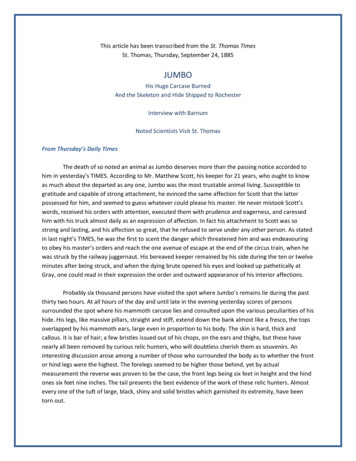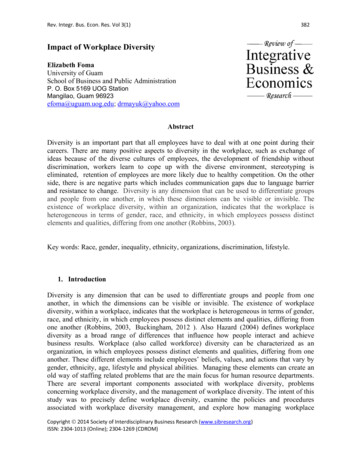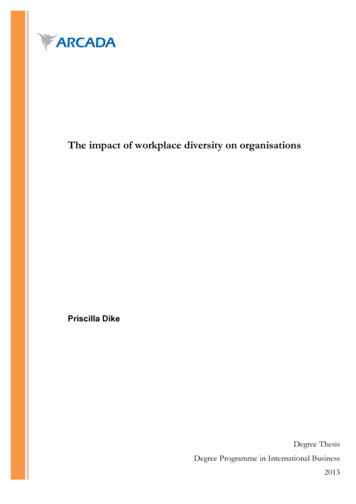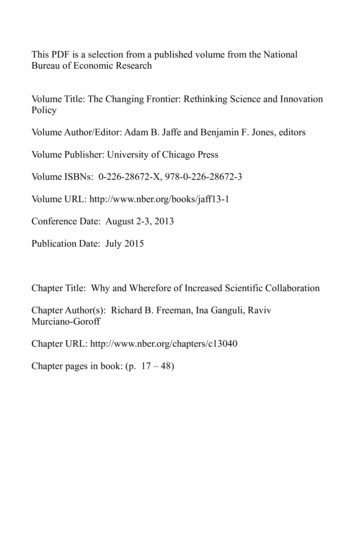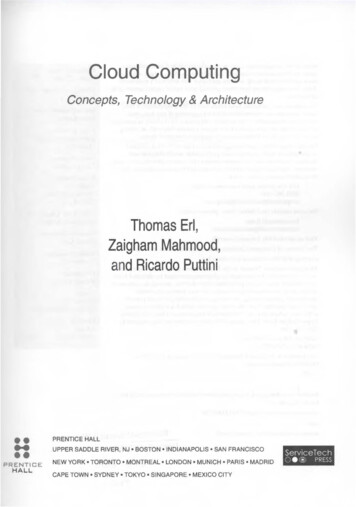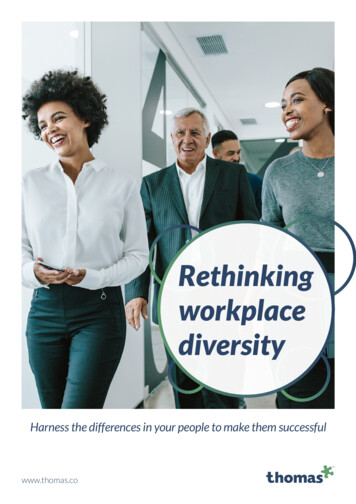
Transcription
RethinkingworkplacediversityHarness the differences in your people to make them successfulwww.thomas.co
Stephen CuppelloPsychology Data AnalystThomas InternationalConnect withStephenStephen has been a member of Thomas International’sPsychology team since 2016. As well as conducting bigdata benchmarking studies in organisations, supportingthe research and development of new tools and headingup the psychometric validation of Thomas’ portfolio ofassessments globally, he is the key consultant involvedin adverse impact analysis as well as supporting diversityand inclusion efforts at Thomas. He has a Master’s degreein Applied Psychology of Intellectual Disability and a keeninterest in advocating for disadvantaged groups.You can contact Stephen by emailing stephenc@thomas.co.ukABOUT THE AUTHORSCharlotte PurdieFormer HR AdvisorThomas InternationalCharlotte joined Thomas in March 2015 and has HRexperience in the retail and pharmaceutical sectors. Priorto embarking on a career in HR, Charlotte graduatedwith a first-class honours degree in Law and this iswhere her passion for HR, in particular employment law,stemmed from. In November 2016, Charlotte successfullycompleted her CIPD Level 7 and has enjoyed a career inHR since 2011.Connect withCharlotte2As Thomas’s HR Advisor, Charlotte’s role focuses onemployee relations, employment law, performancemanagement and recruitment, bringing fairness, equalityand consistency to the business. Charlotte also worksclosely with managers across the business on core HRareas, including recruitment, onboarding and key HRprojects.
INTRODUCTIONWorkplace diversity has the power to instil feelings of belonging (O’Donovan, 2018), to increaseprofits (McKinsey & Company, 2017), lead to more innovation (Nathan & Lee, 2013), drive betterdecisions (Levine et al., 2014) and make teams more productive (Neuman et al., 1999). However, it’salso been attributed with poorer performance (Guillaume et al., 2017), poorer collaboration (Forbes,2011) and the cause of feelings of resentment and mistrust within organisations (Galinsky et al., 2015).It’s a hot topic in both HR and psychology literature and with more and more organisationsembarking on diversity programmes, it’s important to understand what it means, what it can bringto organisations and how to capitalise on the benefits whilst being aware of the inherent challenges.As opinion shifts from framing diversity as primarily a moral concern, this whitepaper also aims tomake the case for alternative forms of diversity, such as personality, and the impact they can have.Diversity is difference. Both visible and invisible; subjectiveand selective; socially constructed yet based on realexperience; it has the power to lead ton both feelings ofinclusion and of intimidation.– Stephen Cuppello3
KEY STATISTICS1. The Case for Workplace Diversity71%85%of millennials feelopportunities arenot equal for allof CEOs whoseorganisations have aD&I strategy say ithas enhanced businessperformance(PwC, 2015b)(PwC, 2015a)51%of employers believediversity helps introducestaff with unique skillsinto the workforceIn the UK, for every10% increase in genderdiversity in exec team, EBITrose by 3.5%. Despite this,there’s an average of only 12%females in exec teams(McKinsey & Company, 2017)(Robert Walters, 2017)85%54%of senior executives globallyagreed that diversity is soimportant as differentperspectives driveinnovationof employers say diversityis crucial to ensure thatthey are doing businessethically(Forbes, 2011)4(Robert Walters, 2017)
77%of CEOs claimed theirD&I strategy has had a directpositive effect on customersatisfaction(PwC, 2015a)RETHINKING WORKPLACE DIVERSITYExtraversion diversity in teams better socialcohesion (Barrick et al., 1998)Adjustment diversity in teams better teamperformance (Neuman et al., 1999)2. Challenges to Workplace Diversity45%of employers don'tmeasure workplacediversity(Robert Walters, 2017)41%of employers feel diversitycan lead to challengeswith collaboration(Robert Walters, 2017)RETHINKING WORKPLACE DIVERSITYConscientiousness diversity in teams worseperformance (Barrick et al., 1998)Agreeableness diversity in teams worse socialcohesion and more conflict (Barrick et al., 1998)Diversity in well-being in teams worse teamperformance (Barsade et al., 2000)545%of employers feel theirrecruitment tools areineffective at attractingdiverse talent(Robert Walters, 2017)41%of senior execs feel failureto connect diversityissues to businessdrivers is an issue(Forbes, 2011)
THE CASE FOR WORKPLACEDIVERSITYOne reason workplace diversity is so importantstems from a moral argument, namely that everyindividual should have the opportunity to bethe best they can be. It’s a convincing argumentand employers are bought into this idea with54% citing diversity as something that is crucialto ensuring they are doing business ethically(Robert Walters, 2017) and indeed this senseof equality is assured by law (UK Equality Act,2010).Gains from workplace diversity are not justmoral. Top quartile companies for diversitywere found to be more likely to financiallyoutperform industry medians than bottomquartile companies for gender diversity (by16%) and ethnic diversity (by 35%) (McKinsey& Company, 2017). Organisations with femaleboard representation outperformed thosewithout by 26% in share price performance(Credit Suisse, 2012). Academics have suggestedfinancial benefits from diversity arise fromvaried approaches and perspectives leadingto more ideas and innovation which in turnleads to better decision making, more complexthinking and ultimately being better equippedfor unforeseen challenges (O’Donovan, 2018).There’s a strong case to be made for the advantages of the variety of perspectives and approachesthat diversity brings.Workplace diversity brings different perspectives on how to approach tasks. Diverse seniormanagement teams are more likely to focus on innovation (Talke et al., 2011) and have been foundto be more likely to introduce product innovations than homogenous ones (Nathan & Lee, 2013).“DIVERSITY SHAPES HOW WE VIEW SITUATIONS, AS COGNITIVEFUNCTIONING AND ATTITUDES VARY WITH DEMOGRAPHICS.”Diverse teams also have the potential to be more productive and make better decisions. When teammembers approach tasks differently, task-related conflicts are more frequent. Effective handlingof these conflicts results in better consideration of all aspects of the task and subsequently bettersolutions. In a research study, ethnic diversity in teams was found to lead to an increase in scrutinyand ultimately better decision making and performance on a market pricing task (Levine et al., 2014).6
Another study found diverse juries deliberate more perspectives more accurately than homogenousones (Sommers, 2006).There are also more practical concerns to creating a diverse workforce. Demographics of both thegeneral and working population of the UK have shifted and pushes for diversity are needed to attractstaff with unique skills. For staff joining the workforce, 80% stated potential employer’s diversity andinclusion policy was an important factor in whether they chose to join a company (PwC, 2015b).Demographic shifts are an important consideration with clients as well as employees. RobertWalters (2017) reported that two thirds of employers believed a diverse workforce was needed tobetter serve their diverse customer base.RETHINKING WORKPLACE DIVERSITYMost research and industry literature has placedthe matter of diversity as rooted solely in readilydetected demographics (Jackson et al., 2003), suchas age, gender and race, and how they related topositive or negative work outcomes (Guillaume etal., 2017). Diversity is broader than this though.“DIVERSITY ENCOMPASSES ANY ATTRIBUTE THAT CAN LEAD A PERSONTO PERCEIVE ANOTHER AS DIFFERENT FROM THEMSELVES.”Personality diversity has long been proposed to have an impact on the effectiveness of teams. Asearly as the 50s, research found groups with heterogeneity of personality were better at solvingproblems (Hoffman, 1959). These ideas are again starting to gain traction and research attention.Studies have also looked to investigate the interplay between demographics and personality and howthis impacts workplace diversity. Flynn et al. (2001) suggested that the effects of diversity on teamswere moderated by personality traits. Demographically dissimilar people were perceived morefavourably if they were more extraverted and showed higher capacity for self-monitoring. This in turnled to greater social integration and performance. This makes sense, as being both gregarious andemotionally intelligent would allow a person to quickly get others to warm to them. Curiosity has alsobeen found to positively moderate team performance in diverse teams (Homan et al., 2008). Again, thisseems logical as highly curious people are more likely to appreciate novel perspectives and entertainthem.7
Teams that displayeddiversity in terms ofextraversion have been found tohave better social cohesion(Barrick et al., 1998).A similar study found thatdiversity in terms of intelligencewas correlated with bettercommunication and less conflict(Bagshaw, 2004). It’s likely that whenthere are noticeable differences betweenpeople, they assume roles within thegroup dynamic more naturally and soteams become more cohesive andmore productive.8Another study founddiversity in terms ofadjustment andextraversion led to better teamperformance(Neuman et al., 1999).
5THE BIG 5 MODELExtraversionEmotional StabilityAgreeablenessConscientiousnessOpenness to ExperienceThe five-factor personality model was first proposed by Norman (1963) anddescribes how our personality can be defined within these factors. The modelpresented here is based on Digman’s (1990) version. Its strong evidencebase has led to it being commonly used as a personality measure in academicliterature, including research into personality diversity.HIGH POTENTIALConscientiousnessRisk ApproachAdjustmentAmbiguity AcceptanceCuriosityCompetitivenessThis model of high potential was proposed by McRae and Furnham (2014)and forms the basis of High Potential Trait Indicator (HPTI). It has drawnelements from the Big Five Model and many factors are strongly correlated.Conscientiousness factors are similar, as are Adjustment and EmotionalStability, and Curiosity and Ambiguity Acceptance relate to Openness toExperience. It has the potential to be used as a tool to assess team diversity.DISC THEORYDominanceSteadinessInfluenceComplianceA model of behavioural preferences, rather than personality, DISC theoryunderpins the Personality Profile Analysis (PPA). There are overlaps withthe academic Big Five Model: the active factors of Dominance and Influencecapture elements of Extraversion and Steadiness has similarities withAgreeableness. An advantage of the PPA when looking at diversity is its easeof application to team audits, comparing individual member profiles.9
CHALLENGES TOWORKPLACE DIVERSITYDespite the apparent advantages of creating a diverse workforce, the reality is less clear cut. Firstly,it’s not always an easy thing to achieve. Despite 85% of employers citing diversity as important, only46% have programmes in place to attract diverse talent and 45% felt their recruitment tools wereineffective at attracting diverse talent (Robert Walters, 2017). Cost implications have been suggestedas one reason for this, with 46% of senior executives feeling budget was a major hurdle to diversity(Forbes, 2011). Costs can certainly add up with specialist staff, employee training, adaptations toworking conditions, extra support and new benefits amongst those that need to be considered.LEABNOASERLOW COSTMODERATEHIGHCOSTSKY HIGHOther business obstacles that have been reported include a lack of consensus over who is responsiblefor supporting diversity initiatives and programmes that have been put in place are not alwaysexecuted well or not connected to business drivers.Even when the momentum has been generated in the business and structures are in place to supportdiversity efforts, the path to a productive, diverse workforce isn’t always straight forward.“BIASES EXIST IN RECRUITMENT AND PROGRESSION PROCESSES.”Job postings that unintentionally use language stereotypically ascribed to men, are less appealing towomen. This isn’t because they feel like they can’t do the job, but that they feel the organisation is notright for them (Gaucher et al., 2011). Throughout the recruitment process too, there’s a large bodyof evidence demonstrating that unconscious bias disadvantages some groups (e.g. Uhlmann & Cohen,2005).10
There are also potential issues when diversity exists within the business.“GROUPS AREN’T ALWAYS SUCCESSFUL AT HARNESSING THE POTENTIALADVANTAGES OF DIVERSITY.”Just putting diversity in place, without proactivelymanaging conflict arising from differences inperspectives, will not bring benefits. It’s beensuggested that the extent to which diversity canbenefit a group is dependent on how apparentdifferences are, how well the group handles biasand how well the group can capitalise on the varietyof perspectives (Guillaume et al., 2017). There’salso a part to play for the type of organisation. Byreviewing recent studies, Guillaume et al. (2017)found that diversity only improved the performanceof organisations that were pursuing growth orinnovation. For those with low growth or lowinnovation strategies, diversity was actually relatedto worse performance.Another matter involves how diversity strategiesare posed to majority groups. Diversity can beviewed as a source of resentment and mistrustand this can lead to resistance which hindersprogress. Majority groups have been shown tohave lower workplace engagement in more diversegroups (Tsui et al., 1992). To give an exampleof this, the BBC recently suffered a significantbacklash following a job post exclusively forblack, Asian and minority ethnic candidates(HR Grapevine, 2017).“MAJORITY GROUP
Challenges to Workplace Diversity Extraversion diversity in teams better social cohesion (Barrick et al., 1998) . financial benefits from diversity arise from varied approaches and perspectives leading to more ideas and innovation which in turn leads to better decision making, more complex thinking and ultimately being better equipped for unforeseen challenges (O’Donovan, 2018). Diverse .

